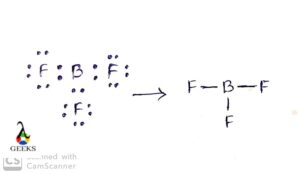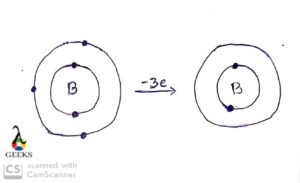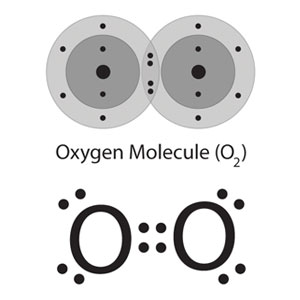Boron Lewis dot Structure shows the different types of compounds of the Boron (an exception in case of fulfilling octet in periodic table). This article would discuss about the Lewis dot structure of those compounds. The drawings of the structures would deliver the idea of electronic reaction between the elements.
The compounds of Boron that would be described with drawing s of Lewis dot structures are being listed below:
Boron Lewis dot structure for Boron trichloride
Boron tricholride that is BCl3 consists of three single bonds between Boron and three Chlorine atoms. Boron is the central atom, which needs three electrons to have total six electrons in its last electron shell it does not necessarily needs to fulfil its octet.
The Lewis dot structure of Boron trichlortde enhances the idea about sharing electrons. Boron has three valance electrons and three chlorine atoms have (3*7= 21) valance electrons. Therefore, total amount of valance electrons take place in the formation of BCl3 is 24.
The central atom boron shares each of its three electrons with the individual chlorine atoms and each of the chlorine atoms shares one Valance electron with Boron. This sharing creates double bonds between the central atoms and chlorines. Therefore, this compound is considered as covalent compound.
Read more about Covalent compound

The above mentioned double bond is not incorrect but as Boron is not bound to fulfil its octet therefore; another structure can be considered here as well. That the structure with three single bonds with the three shared electrons of Boron.
The right structure must be found by calculating the formal charge of the elements. Hence, we will calculate the formal charge of chlorine atom and then we will proceed through the calculation for central atom Boron.
If we take one pair of electrons in between one chlorine atom and the Boron then one double bonding would take place. In this case, it is needed to calculate the formal changes to find out the most stable structure of BCl3. The formula of calculating formal charge of the atoms is:
Valance electron – Non-bonding valance electrons – (bonding electrons/2)
Therefore the Formal charge of the first Chlorine atoms is 7-6-(2/2) = 0
The Formal charge of second Chlorine atom (which one create double bond) is 7-4- (4/2) = +1
The Formal charge of third chlorine atom is same as the first chlorine atom
The Formal charge of the Boron atom is 3-0- (8/2) = -1

Now, the next structure with all the single bonds shows that the formal charges of all the atoms including the central Boron are zero. A Lewis structure is always stable when all the atoms hold same zero charges. Therefore, this second structure with single bonds is considered o be the real and stable Lewis dot structure of BCl3.
Boron Lewis dot structure for Boron trifluoride
Fluorine is also a halogen element like chlorine. Therefore, The properties shown by Boron trifluoride is quite similar as boron trichloride. The Lewis Dot structure would identify the similarities with proper description.
Fluorine is the least electronegative element in the periodic able. Therefore. It van not be centred in the Lewis structure, As Boron needs three electron in its last electronic shell and fluorine needs one electron, therefore; they shares their electron same as three fluorine atoms.

There fluorine atom and one boron makes BF3 as Boron trifluoride. The Lewis structure shows that the compound holds Trigonal planner geometry and in the case of this compound is the Fluorine atoms hold zero formal charges. It is made of three single bonds between Boron and three Fluorine atoms.
Fluorine gets octet satisfaction by this sharing and as it is fine for Boron to have six electrons to be stable therefore, it holds six electrons. The total number of valance electrons in this compound is also twenty-four.
Lewis Dot Structure of Boron triiodide
Iodine is the largest halogen element in the series. As it is also a halogen element it creates the same Lewis structure as the BCl3 and BF3. This compound follows the same theory and demographic structure as well.

Lewis dot structure of BI3 (Boron triiodide) shows that all the atoms have similar formal charges that is zero. It also possesses Trigonal planner geometry and sp2 hybridisation structure.
The Lewis dot structure shares the information about this compound as it has six boning electron and single bonds are generated in this compound by following the same theory as the formation theory of BCl3 and BF3.
However, the compound holds lone pair that is also denoted by the Lewis dot structure. It informs that the compound is nonpolar and covalent as electron sharing talks place between the atoms. The similar structure is only different from the other two Boron-halogen compounds is the larger size of the halogen.
Lewis Dot structure of Boron ion
At first, it is needed to identify the normal Lewis structure of Boron atom, which stays in the periodic table. It has total three-valance electron in the highest energy level that is the last electronic shell.

Now, the Lewis dot structure of Boron ion tells that the element is an exception in the case of filling octet. Other atoms seeks for the similar configuration as the nearest noble gas but Boron can get enough stability by possessing six valance electron in its outermost shell.
Boron is found to be interested in getting 3+ charges by losing its valance electrons. In addition, that B3+ is known as the Boron ion in chemistry. However, loosing those electrons creates a complete shell configuration, which is quite stable.
The loss of electrons from the highest energy level or the outer shell of the atom creates vacant in the outer shell as the very first shell of the Boron atom hold only two electrons, which is a complete configuration. This information is structured by the Lewis Dot structure of Boron ion.
Lewis Dot Structure of Boron trihydride
The exceptional behaviour from the octet rule of Boron is uniquely gives different statements regard every compound of Boron. The Lewis dot structure of Boron trihydride is another one, which could be described as an example here.

Boron trihydride that is BH3 holds the idea of having three hydrogen atoms in in binding with the Centre atom Boron. Boron has three valance electrons, which we are already known to. Three hydrogen atoms have three electrons only. Therefore the total number of valance electrons in the formation of this compound is (3+3) = 6 electrons.
For getting ultimate stability like helium (nearest noble gas), hydrogen needs one more electron in its only one electronic shell. Two electrons would fulfil its octet satisfaction. Therefore the three electron lost by the Boron are taken by the three Hydrogen atoms.
As Boron can accept only six electrons to get stability, it creates mutual adhering of electro s with hydrogen atoms. Therefore, the situation takes place like the mutual sharing the three electrons between one Boron with three valance electrons and three hydrogen with in valance election for each.
Through the implementation of three single bonds, the structure of BH3 generates a stable compound. Moreover,. This compound is similar as the other compounds discussed over this article with similar hybridisation and similar geometry.
Lewis dot structure of Boron and oxygen
Lewis dot structure of Boron and oxygen ate completely different from each other, which shows the exceptional figure of Boron and natural structure of oxygen.
Let us look on their Lewis Dot structure description individually:
Boron: this is an exceptional compound, which does not need to maintain the octet rule like other elements in the periodic table. All the elements seek filled shell with the similar electronic configuration of the nearest noble gas but Boron could be happy by holding six electrons inn its highest energy level.

Boron has total five electrons ad in the very first shell it holds two electrons. In the next shell, it has three electrons, which are considered as its valance electrons.
The Lewis structure of this element shows that if it can lose those three valance electrons from the highest energy level it would get a filled shell and get high stability in the periodic table.
Oxygen: Now in the case of Oxygen, it is required to identify the special Lewis Dot structure oxygen. In the very first place it is needed to identify, the total number of electrons is sixteen and in the outermost shell, it possesses six valance electrons. According to the octet rule it needs two more electrons in hits highest energy level.

Oxygen does not stay as a single atom it exists as O2 molecule. It possesses double of valance electrons that is total twelve valance electrons. Each of the oxygen molecule shares two electrons with each other, which is clearly described in the structure.
They create double bond with each other as double electrons from each of atom take place in the sharing. By mitigating the octet rule, they create this bonding frequently with the help of twelve valance electrons.
Frequently asked Questions (FAQs)
Question 1: How is Boron exceptional from octet rule?
Answer: Boron does not need to fill the octet by getting eight electrons in the last shell. It can be satisfied by having only six electrons. This is how the element is exceptional than other.
Question 2: Find the similarity between BH3 and BI3.
Answer: Both the compound have similar hybridisation structure and molecular geometry. Iodine and Hydrogen both the elements create single bonds with the centre atom Boron.
Question 3: How many lone pair is possessed by BI3?
Answer: BI3 possessed 9 lone pair in its structure.
Question 4: Find the formal charges of each atom in BF3.
Answer: The formal charges of each atom in BF3 are zero.
Formula of finding Formal charge is, valance electrons – non-bonding electrons – (bonding electrons/2)
Therefore, For Boron it is 3-3-(2/2) = 0
For each of the Fluorine atoms it is 7-6-(2/2) = 0
Question 5: How many bond pairs are there in BI3?
Answer: There are three Bond pairs in BI3.

Hi…..I am Sarnali Mukherjee, a graduate from the University of Calcutta. I love to teach and share knowledge on chemistry. I have gradually gained interest in article writing since one year ago. I would love to acquire more knowledge on my subject in the future.
Let’s connect through LinkedIn: